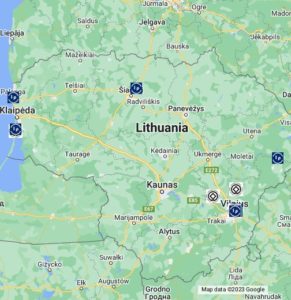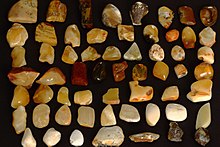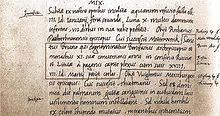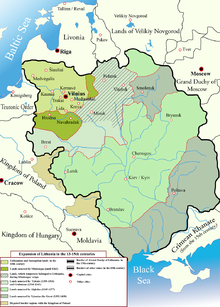LITHUANIA MAP

Lithuania Map, Lithuania is a country located in northern Europe, bordered by Latvia to the north, Belarus to the east and south, Poland to the south, and the Baltic Sea to the west. As of 2021, the estimated population of Lithuania is around 2.8 million people.Lithuania has a long and complex history that dates back to the 13th century. At that time, it was a powerful state that extended from the Baltic Sea to the Black Sea. In the late 14th century, Lithuania formed a political union with Poland, known as the Polish-Lithuanian Commonwealth, which lasted until the late 18th century.During the 20th century, Lithuania was occupied by the Soviet Union twice, first from 1940 to 1941, and then from 1944 to 1990. In 1990, Lithuania became the first Soviet republic to declare independence, and it gained international recognition the following year.Since then, Lithuania has developed into a modern European country with a market economy and a high-income status. It joined the European Union and NATO in 2004, and has since become an important player in the region. The country has a rich cultural heritage, with a unique language and traditional customs that are still celebrated today.
10 largest cities in Lithuania
- Vilnius – Population: 542,366. Vilnius is the capital and largest city of Lithuania. It is known for its well-preserved Old Town, which is a UNESCO World Heritage Site, as well as its numerous churches, historic buildings, and vibrant cultural scene.
- Kaunas – Population: 280,085. Kaunas is the second-largest city in Lithuania and an important cultural and industrial center. It is known for its many museums, including the Museum of the History of Lithuanian Medicine and Pharmacy, and its well-preserved Old Town.
- Klaipėda – Population: 147,405. Klaipėda is a major seaport and the third-largest city in Lithuania. It is known for its historic architecture, including the Klaipėda Castle, as well as its beaches and coastal resorts.
- Šiauliai – Population: 100,167. Šiauliai is the fourth-largest city in Lithuania and an important center of industry and education. It is known for the Hill of Crosses, a pilgrimage site with thousands of crosses.
- Panevėžys – Population: 86,924. Panevėžys is an important center of industry, commerce, and transportation. It is known for its well-preserved Old Town and numerous parks and green spaces.
- Alytus – Population: 51,646. Alytus is a historic city with a rich cultural heritage. It is known for its numerous festivals and events, as well as its beautiful parks and nature reserves.
- Marijampolė – Population: 36,836. Marijampolė is a city with a long and rich history, dating back to the 17th century. It is known for its well-preserved Old Town and historic landmarks, such as the church of Sts. Peter and Paul.
- Mažeikiai – Population: 35,033. Mažeikiai is a city in the northwestern part of Lithuania known for its oil refinery, which is the largest in the Baltic states. It is also known for its numerous parks and nature reserves.
- Jonava – Population: 31,921. Jonava is a city with a strong industrial and agricultural base. It is known for its well-preserved Old Town and numerous cultural events, such as the Jonava Jazz Festival.
- Utena – Population: 28,497. Utena is a city in northeastern Lithuania known for its numerous lakes, forests, and natural beauty. It is also home to the Aukštaitija National Park, which is one of the most popular tourist destinations in the country.
Lithuania is located in Northern Europe and shares borders with the following countries
- Latvia to the north
- Belarus to the east and southeast
- Poland to the south
- Russia (Kaliningrad Oblast) to the southwest.
10 of the most popular hotels in Lithuania
- Kempinski Hotel Cathedral Square – Universiteto g. 14, Vilnius 01122, Lithuania – https://www.kempinski.com/en/vilnius/hotel-cathedral-square/
- Narutis Hotel – Pilies g. 24, Vilnius 01123, Lithuania – https://narutis.com/
- Grand Hotel Kempinski Vilnius – Universiteto g. 14, Vilnius 01122, Lithuania – https://www.kempinski.com/en/vilnius/grand-hotel-vilnius/
- Radisson Blu Royal Astorija Hotel – Didzioji g. 35/2, Vilnius 01128, Lithuania – https://www.radissonhotels.com/en-us/hotels/radisson-blu-vilnius-astorija
- Artagonist Art Hotel – Pilies g. 34, Vilnius 01123, Lithuania – https://www.artagonist.lt/en/
- Stikliai Hotel – Gaono g. 7, Vilnius 01131, Lithuania – https://www.stikliaihotel.lt/en/
- Hotel PACAI – Didzioji g. 7, Vilnius 01128, Lithuania – https://hotelpacai.com/
- Amberton Hotel – L. Stuokos-Guceviciaus g. 1, Vilnius 01122, Lithuania – https://www.ambertonhotels.com/en/vilnius-hotel/
- Shakespeare Boutique Hotel – Bernardinu g. 8/8, Vilnius 01124, Lithuania – https://www.shakespeare.lt/en/
- Artagonist Hotel Vilnius – Pilies g. 34, Vilnius 01123, Lithuania – https://www.artagonist.lt/en/
HEALTH INSURANCE LITHUANIA

As a tourist or expat visiting Lithuania, it is recommended to have travel insurance that includes medical coverage for the duration of your stay. It is also advisable to research and compare policies from different health insurance providers to ensure you are getting the best coverage for your needs. For Lithuanian citizens, health insurance is mandatory and is typically provided through their employer or the National Health Insurance Fund (NHIF). The NHIF covers basic healthcare services, including primary care, emergency care, and some specialized care, while also providing partial coverage for prescription medications and medical devices. Citizens can also choose to purchase additional private health insurance to supplement their coverage and receive more comprehensive care. For expats living and working in Lithuania, it is important to obtain health insurance that provides coverage for both routine medical care and emergency services. Many international insurance providers offer policies specifically designed for expats that can be customized to meet their specific needs. These policies may cover medical services such as doctor visits, hospitalization, prescription medications, and even repatriation in the event of a medical emergency.It is important to note that the quality of healthcare in Lithuania is generally good, with many highly trained medical professionals and modern facilities. However, it is recommended to research the specific medical services and facilities available in the area where you will be staying to ensure that you have access to the care you may need.
Lithuania Map
|
Republic of Lithuania
Lietuvos Respublika (Lithuanian)
|
|
|---|---|
| Anthem: Tautiška giesmė “National Hymn” 1:48
|
|
|
Location of Lithuania (dark green)– in Europe (green & dark grey)
– in the European Union (green) – [Legend] |
|
| Capital
and largest city
|
Vilnius 54°41′N 25°19′E |
| Official languages | Lithuanian[1] |
| Ethnic groups
(2021[2])
|
|
| Religion
(2021[3])
|
|
| Demonym(s) | Lithuanian |
| Government | Unitary semi-presidential republic[4][5][6][7] |
| Gitanas Nausėda | |
| Ingrida Šimonytė | |
| Viktorija Čmilytė-Nielsen | |
| Legislature | Seimas |
| Formation | |
| 9 March 1009 | |
| 1236 | |
|
• Coronation of Mindaugas
|
6 July 1253 |
| 2 February 1386 | |
|
• Commonwealth created
|
1 July 1569 |
| 24 October 1795 | |
| 16 February 1918 | |
| 11 March 1990 | |
| 29 March 2004 | |
| 1 May 2004 | |
| Area | |
|
• Total
|
65,300 km2 (25,200 sq mi) (121st) |
|
• Water (%)
|
1.98 (2015)[8] |
| Population | |
|
• 2022 estimate
|
|
|
• Density
|
43/km2 (111.4/sq mi) (138th) |
| GDP (PPP) | 2022 estimate |
|
• Total
|
|
|
• Per capita
|
|
| GDP (nominal) | 2022 estimate |
|
• Total
|
|
|
• Per capita
|
|
| Gini (2020) | medium |
| HDI (2021) | very high · 35th |
| Currency | Euro (€) (EUR) |
| Time zone | UTC+2 (EET) |
|
• Summer (DST)
|
UTC+3 (EEST) |
| Date format | yyyy–mm–dd (CE) |
| Driving side | right |
| Calling code | +370 |
| ISO 3166 code | LT |
| Internet TLD | .lta |
|
Website
lithuania |
|
|
|
Coordinates: 55°N 24°ELithuania (/ˌlɪθjuˈeɪniə/ (![]() listen);[13] Lithuanian: Lietuva [lʲɪɛtʊˈvɐ]), officially the Republic of Lithuania (Lithuanian: Lietuvos Respublika [lʲɪɛtʊˈvoːs rʲɛsˈpʊblʲɪkɐ]), is a country in the Baltic region of Europe.[a] It is one of three Baltic states and lies on the eastern shore of the Baltic Sea. Lithuania shares land borders with Latvia to the north, Belarus to the east and south, Poland to the south, and Russia to the southwest.[b] It has a maritime border with Sweden to the west on the Baltic Sea. Lithuania covers an area of 65,300 km2 (25,200 sq mi), with a population of 2.8 million. Its capital and largest city is Vilnius; other major cities are Kaunas and Klaipėda. Lithuanians belong to the ethno-linguistic group of the Balts and speak Lithuanian, one of only a few living Baltic languages.
listen);[13] Lithuanian: Lietuva [lʲɪɛtʊˈvɐ]), officially the Republic of Lithuania (Lithuanian: Lietuvos Respublika [lʲɪɛtʊˈvoːs rʲɛsˈpʊblʲɪkɐ]), is a country in the Baltic region of Europe.[a] It is one of three Baltic states and lies on the eastern shore of the Baltic Sea. Lithuania shares land borders with Latvia to the north, Belarus to the east and south, Poland to the south, and Russia to the southwest.[b] It has a maritime border with Sweden to the west on the Baltic Sea. Lithuania covers an area of 65,300 km2 (25,200 sq mi), with a population of 2.8 million. Its capital and largest city is Vilnius; other major cities are Kaunas and Klaipėda. Lithuanians belong to the ethno-linguistic group of the Balts and speak Lithuanian, one of only a few living Baltic languages.
For millennia the southeastern shores of the Baltic Sea were inhabited by various Baltic tribes. In the 1230s, Lithuanian lands were united by Mindaugas, becoming king and founding the Kingdom of Lithuania on 6 July 1253. In the 14th century, the Grand Duchy of Lithuania was the largest country in Europe;[19] present-day Lithuania, Belarus, most of Ukraine, and parts of Poland and Russia were all lands of the Grand Duchy. The Crown of the Kingdom of Poland and the Grand Duchy of Lithuania were in a de facto personal union from 1386 with the marriage of the Polish queen Hedwig and Lithuania’s Grand Duke Jogaila, who was crowned King jure uxoris Władysław II Jagiełło of Poland. The Commonwealth of Poland and Lithuania was established by the Union of Lublin in July 1569. The Commonwealth lasted more than two centuries, until neighbouring countries dismantled it in 1772–1795, with the Russian Empire annexing most of Lithuania’s territory. As World War I ended, Lithuania’s Act of Independence was signed on 16 February 1918, founding the modern Republic of Lithuania. In World War II, Lithuania was occupied first by the Soviet Union and then by Nazi Germany. Towards the end of the war in 1944, when the Germans were retreating, the Soviet Union reoccupied Lithuania. Lithuanian armed resistance to the Soviet occupation lasted until the early 1950s. On 11 March 1990, a year before the formal dissolution of the Soviet Union, Lithuania passed the Act of the Re-Establishment of the State of Lithuania, becoming the first Soviet republic to break away when it proclaimed the restoration of its independence.[20]
Lithuania is a developed country, with a high income advanced economy; ranking very high in the Human Development Index. It ranks favourably in terms of civil liberties, press freedom, internet freedom, democratic governance, and peacefulness. Lithuania is a member of the European Union, the Council of Europe, eurozone, the Nordic Investment Bank, Schengen Agreement, NATO and OECD. It also participates in the Nordic-Baltic Eight (NB8) regional co-operation format.
Etymology
The first known record of the name of Lithuania (Lithuanian: Lietuva) is in a 9 March 1009 story of Saint Bruno in the Quedlinburg Chronicle.[21] The Chronicle recorded a Latinized form of the name Lietuva: Litua[22] (pronounced [litua]). Due to the lack of reliable evidence, the true meaning of the name is unknown. Nowadays, scholars still debate the meaning of the word and there are a few plausible versions.[23]
Since Lietuva has a suffix (-uva), the original word should have no suffix.[23] A likely candidate is Lietā. Because many Baltic ethnonyms originated from hydronyms, linguists have searched for its origin among local hydronyms. Usually, such names evolved through the following process: hydronym → toponym → ethnonym.[24] Lietava, a small river not far from Kernavė, the core area of the early Lithuanian state and a possible first capital of the eventual Grand Duchy of Lithuania, is usually credited as the source of the name.[24] However, the river is very small and some find it improbable that such a small and local object could have lent its name to an entire nation. On the other hand, such naming is not unprecedented in world history.[25]
Artūras Dubonis proposed another hypothesis,[26] that Lietuva relates to the word leičiai (plural of leitis). From the middle of the 13th century, leičiai were a distinct warrior social group of the Lithuanian society subordinate to the Lithuanian ruler or the state itself. The word leičiai is used in the 14–16th century historical sources as an ethnonym for Lithuanians (but not Samogitians) and is still used, usually poetically or in historical contexts, in the Latvian language, which is closely related to Lithuanian.[27][28][29]
History

Baltic amber was once a valuable trade resource. It was transported from the region of modern-day Lithuania to the Roman Empire and Egypt through the Amber Road.
The first people settled in the territory of Lithuania after the last glacial period in the 10th millennium BC: Kunda, Neman and Narva cultures.[30] They were traveling hunters and did not form stable settlements. In the 8th millennium BC, the climate became much warmer, and forests developed. The inhabitants of what is now Lithuania then travelled less and engaged in local hunting, gathering and fresh-water fishing. Agriculture did not emerge until the 3rd millennium BC due to a harsh climate and terrain and a lack of suitable tools to cultivate the land. Crafts and trade also started to form at this time. Over a millennium, the Indo-Europeans, who arrived in the 3rd – 2nd millennium BC, mixed with the local population and formed various Baltic tribes.[31]
The Baltic tribes did not maintain close cultural or political contacts with the Roman Empire,[32] but they did maintain trade contacts (see Amber Road). Tacitus, in his study Germania, described the Aesti people, inhabitants of the south-eastern Baltic Sea shores who were probably Balts, around the year 97 AD. The Western Balts differentiated and became known to outside chroniclers first. Ptolemy in the 2nd century AD knew of the Galindians and Yotvingians, and early medieval chroniclers mentioned Old Prussians, Curonians and Semigallians.[33]
The Lithuanian language is considered to be very conservative for its close connection to Indo-European roots. It is believed to have differentiated from the Latvian language, the most closely related existing language, around the 7th century.[34] Traditional Lithuanian pagan customs and mythology, with many archaic elements, were long preserved. Rulers’ bodies were cremated up until the conversion to Christianity: the descriptions of the cremation ceremonies of the grand dukes Algirdas and Kęstutis have survived.[35]
Grand Duchy of Lithuania
From the 9th to the 11th centuries, coastal Balts were subjected to raids by the Vikings,[37] and the kings of Denmark collected tribute at times.[citation needed] During the 10–11th centuries, Lithuanian territories were among the lands paying tribute to Kievan Rus’, and Yaroslav the Wise was among the Ruthenian rulers who invaded Lithuania (from 1040).[citation needed] From the mid-12th century, it was the Lithuanians who were invading Ruthenian territories. In 1183, Polotsk and Pskov were ravaged, and even the distant and powerful Novgorod Republic was repeatedly threatened by the excursions from the emerging Lithuanian war machine toward the end of the 12th century.[38]
From the late 12th century, an organized Lithuanian military force existed; it was used for external raids, plundering and the gathering of slaves. Such military and pecuniary activities fostered social differentiation and triggered a struggle for power in Lithuania. This initiated the formation of early statehood, from which the Grand Duchy of Lithuania developed.[39][40] The disparate Lithuanian tribes along the Nemunas were united into the Lithuanian state by 1219, at the latest.[41] The only Lithuanian Roman Catholic king, Mindaugas, was baptised as a Roman Catholic in 1251 and crowned as King of Lithuania on 6 July 1253.[42]
After his assassination in 1263, pagan Lithuania was a target of the Christian crusades of the Teutonic Knights and the Livonian Order. The siege of Pilėnai is noted for the Lithuanians’ defense against the intruders. Despite the devastating century-long struggle with the Orders, the Grand Duchy of Lithuania expanded rapidly, overtaking former Ruthenian principalities of Kievan Rus’.[43]
On 22 September 1236, the Battle of Saulė between Samogitians and the Livonian Brothers of the Sword took place close to Šiauliai. The Livonian Brothers were defeated during it and their further conquest of the Balts lands were stopped.[44] The battle inspired rebellions among the Curonians, Semigallians, Selonians, Oeselians, tribes previously conquered by the Sword-Brothers. Some thirty years’ worth of conquests on the left bank of Daugava were lost.[45] In 2000, the Lithuanian and Latvian parliaments declared 22 September to be the Day of Baltic Unity.[46]

Trakai Island Castle, the former residence of the Grand Dukes and capital city of the medieval state
According to the legend, Grand Duke Gediminas was once hunting near the Vilnia River; tired after the successful hunt, he settled in for the night and dreamed of a huge Iron Wolf standing on top a hill and howling as strong and loud as a hundred wolves. Krivis (pagan priest) Lizdeika interpreted the dream that the Iron Wolf represents Vilnius Castles. Gediminas, obeying the will of the gods, built the city and gave it the name Vilnius – from the stream of the Vilnia River.[47]
In 1362 or 1363, Grand Duke Algirdas achieved a decisive victory in the Battle of Blue Waters against the Golden Horde and stopped its further expansion in the present-day Ukraine.[48] The victory brought the city of Kyiv and a large part of present-day Ukraine, including sparsely populated Podolia and Dykra, under the control of the expanding Grand Duchy of Lithuania.[49] After taking Kyiv, Lithuania became a direct neighbor and rival of the Grand Duchy of Moscow.[50]
By the end of the 14th century, Lithuania was one of the largest countries in Europe and included present-day Belarus, Ukraine, and parts of Poland and Russia.[51] The geopolitical situation between the west and the east determined the multicultural and multi-confessional character of the Grand Duchy of Lithuania. The ruling elite practised religious tolerance and the Chancery Slavonic language was used as an auxiliary language to Latin for official documents.[52]
In 1385, the Grand Duke Jogaila accepted Poland’s offer to become its king. Jogaila embarked on gradual Christianization of Lithuania and established a personal union between Poland and Lithuania. Lithuania was one of the last pagan areas of Europe to adopt Christianity. While territories to the north had been Christianized in 1186 by Western merchants and missionaries who formed the Order of the Brothers and the Sword to spread Christianity through military organization, the Lithuanians had defeated the Order’s militant efforts in 1236.[53][54]

Battle of Grunwald and Vytautas the Great in the centre
After two civil wars, Vytautas the Great became the Grand Duke of Lithuania in 1392. During his reign, Lithuania reached the peak of its territorial expansion, centralization of the state began, and the Lithuanian nobility became increasingly prominent in state politics. In the great Battle of the Vorskla River in 1399, the combined forces of Tokhtamysh and Vytautas were defeated by the Mongols. Thanks to close cooperation, the armies of Lithuania and Poland achieved a victory over the Teutonic Knights in 1410 at the Battle of Grunwald, one of the largest battles of medieval Europe.[55][56][57]
In January 1429, at the Congress of Lutsk Vytautas received the title of King of Lithuania with the backing of Sigismund, Holy Roman Emperor, but the envoys who were transporting the crown were stopped by Polish magnates in autumn of 1430. Another crown was sent, but Vytautas died in the Trakai Island Castle several days before it reached Lithuania. He was buried in the Cathedral of Vilnius.[58]
After the deaths of Jogaila and Vytautas, the Lithuanian nobility attempted to break the union between Poland and Lithuania, independently selecting Grand Dukes from the Jagiellon dynasty. But, at the end of the 15th century, Lithuania was forced to seek a closer alliance with Poland when the growing power of the Grand Duchy of Moscow threatened Lithuania’s Russian principalities and sparked the Muscovite–Lithuanian Wars and the Livonian War.

The victory of the Polish-Lithuanian forces over the Muscovites at the Battle of Orsha in 1514
On 8 September 1514, the Battle of Orsha between Lithuanians, commanded by the Grand Hetman Konstanty Ostrogski, and Muscovites was fought. According to Rerum Moscoviticarum Commentarii by Sigismund von Herberstein, the primary source for information on the battle, the much smaller army of Poland–Lithuania (under 30,000 men) defeated a force of 80,000 Muscovite soldiers, capturing their camp and commander.[59] The battle destroyed a military alliance against Lithuania and Poland. Thousands of Muscovites were captured as prisoners and used as labourers in the Lithuanian manors, while Konstanty Ostrogski delivered the captured Muscovite flags to the Cathedral of Vilnius.[60][61]
The Livonian War was ceased for ten years with a Truce of Yam-Zapolsky signed on 15 January 1582 according to which the already Polish–Lithuanian Commonwealth recovered Livonia, Polotsk and Velizh, but transferred Velikiye Luki to the Tsardom of Russia. The truce was extended for twenty years in 1600, when a diplomatic mission to Moscow led by Lew Sapieha concluded negotiations with Tsar Boris Godunov.[62] The truce was broken when the Poles invaded Muscovy in 1605.






